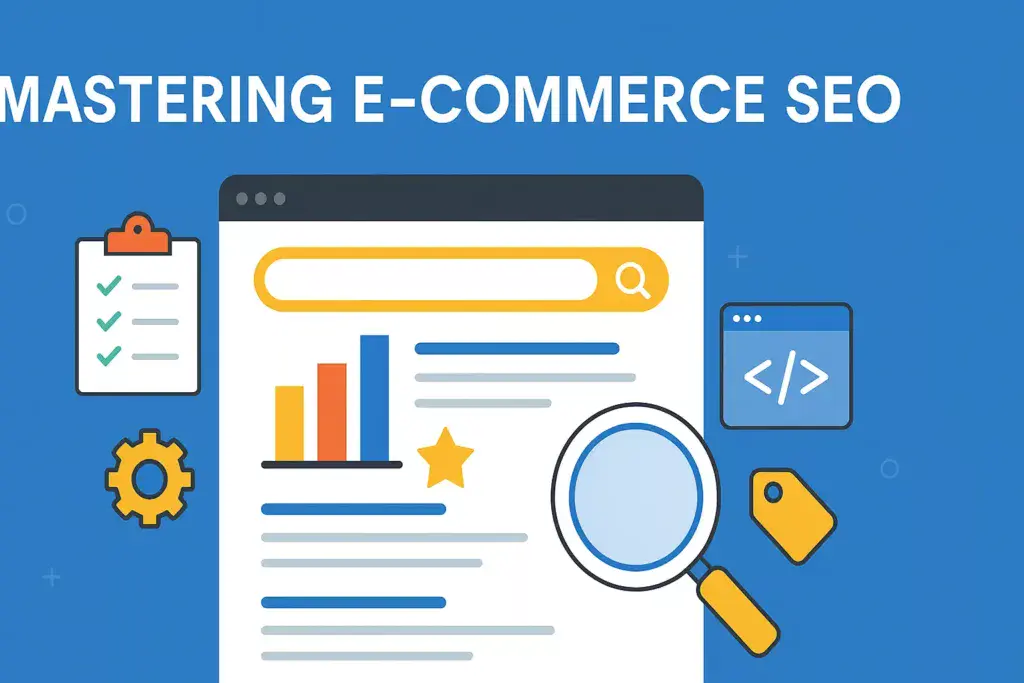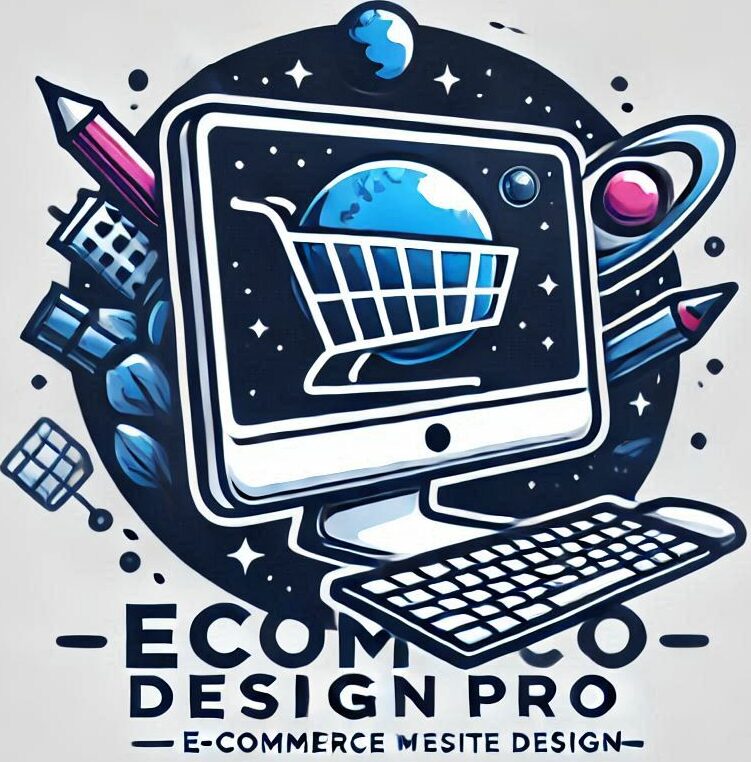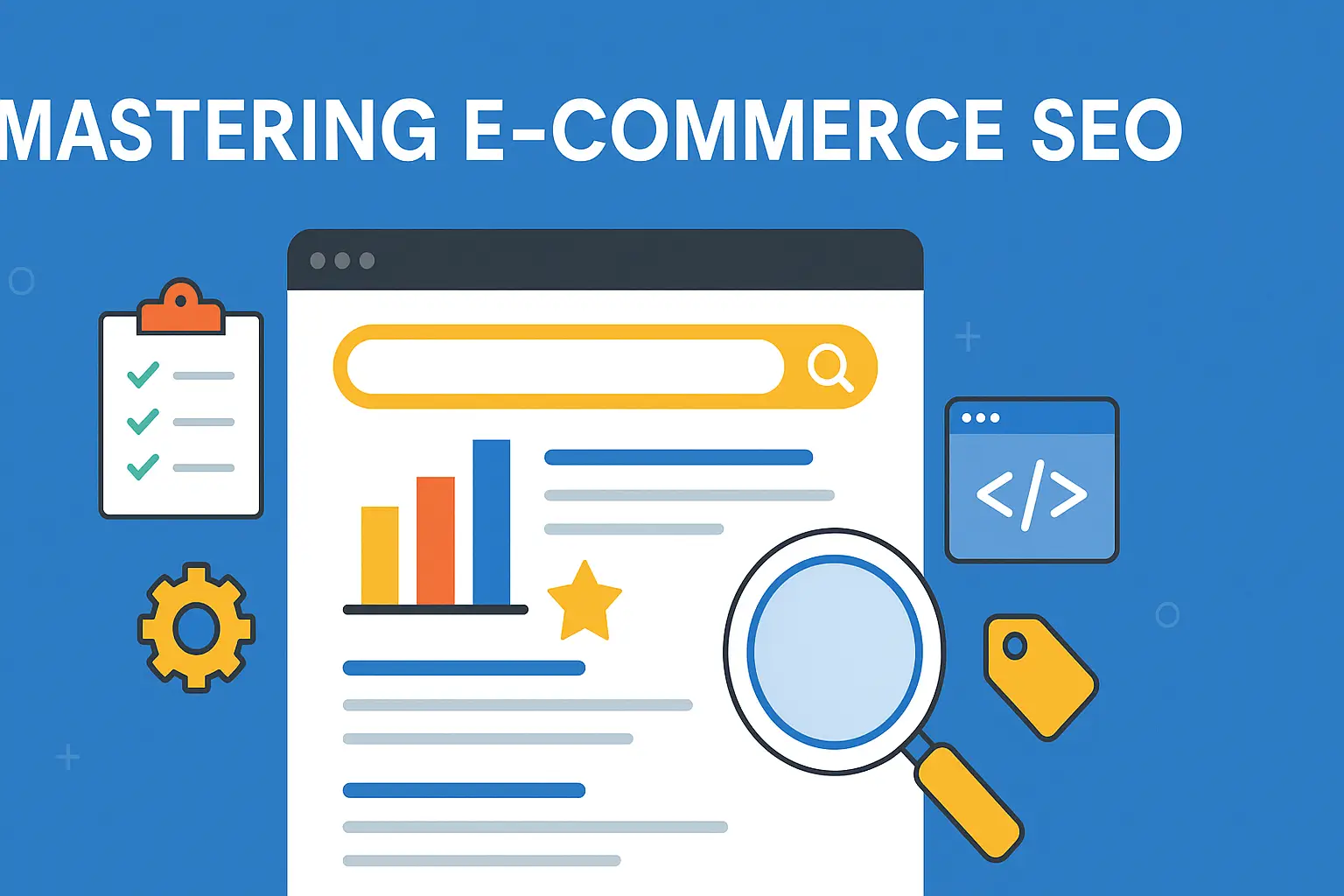
I. Introduction to E-commerce SEO
In today’s increasingly digital environment, the role of Search Engine Optimization (SEO) in the e-commerce sector is crucial. With the rise in popularity of online shopping, it is imperative for businesses to make their websites easily accessible to potential customers. E-commerce SEO is essential for enhancing visibility on search engines, increasing organic traffic, and ultimately boosting sales.
A. Importance of SEO in E-commerce
For e-commerce platforms, effective SEO is not merely beneficial; it is essential. With countless products competing for consumer attention, distinguishing oneself in a saturated online marketplace necessitates a strategic SEO approach. By optimizing their websites for search engines, e-commerce companies can enhance their rankings, attract qualified leads, and convert visitors into customers. Furthermore, a well-executed SEO strategy can facilitate long-term growth, as organic traffic typically yields a higher return on investment (ROI) than paid advertising.
B. Overview of Current Trends
As the e-commerce landscape changes, so must the SEO strategies employed by businesses to stay competitive. Current trends include a heightened emphasis on user experience (UX), mobile-first indexing, and the incorporation of artificial intelligence (AI) in search algorithms. Additionally, the optimization for voice search has become increasingly important as more consumers utilize smart devices for purchases. Staying updated on these trends enables e-commerce businesses to adjust their SEO strategies effectively, ensuring they capture the attention of their target audience.
C. Challenges Faced by E-commerce Websites
While e-commerce SEO offers numerous opportunities, businesses encounter several challenges. The intense competition in the online market can hinder visibility for even well-optimized websites. Furthermore, e-commerce sites often grapple with issues such as duplicate content, intricate site structures, and the necessity for continuous updates to product listings. Successfully navigating these challenges demands a thorough understanding of SEO principles and a commitment to ongoing optimization. As the digital landscape evolves, e-commerce entities must remain flexible and responsive to changes in consumer behavior and technological advancements.
In conclusion, e-commerce SEO is a fundamental element of a successful online retail strategy. By recognizing its significance, keeping up with current trends, and addressing the inherent challenges, businesses can position themselves for sustained growth and success in the competitive e-commerce arena.
II. On-page SEO Strategies
On-page SEO encompasses practices applied directly on a website to improve its visibility and ranking in search engine results. For e-commerce sites, where competition is fierce and user experience is critical, effective on-page SEO strategies are vital for attracting organic traffic and converting visitors into customers. Below are key areas to focus on for optimizing on-page elements.
A. Optimizing Product Descriptions
Product descriptions serve not only to inform potential customers about the features and benefits of a product but are also essential for SEO. Crafting unique, engaging, and informative descriptions assists search engines in understanding the page content while offering valuable information to users. Here are some best practices:
- Use Unique Content: Avoid using duplicate manufacturer descriptions. Instead, create original content that emphasizes the product’s distinctive features.
- Incorporate Keywords Naturally: Identify relevant keywords that potential customers are likely to use and seamlessly integrate them into the description. Focus on long-tail keywords that reflect specific buyer intent.
- Highlight Benefits and Features: Clearly delineate what makes the product appealing. Use bullet points for key features to improve readability and engagement.
- Utilize Visual Aids: Incorporate high-quality images, videos, and infographics to complement the text and provide a richer understanding of the product.
B. Utilizing Keywords Effectively
Keyword research is fundamental to successful on-page SEO. Identifying the right keywords requires an understanding of the language used by your target audience and the terms they search for when looking for products. Here’s how to effectively use keywords:
- Conduct Thorough Keyword Research: Utilize tools such as Google Keyword Planner or SEMrush to identify relevant keywords, their search volume, and levels of competition. Focus on both primary and secondary keywords.
- Strategically Place Keywords: Include primary keywords in crucial locations such as title tags, meta descriptions, headers (H1, H2), and throughout the content. However, avoid keyword stuffing, as it can lead to penalties from search engines.
- Optimize URL Structures: Ensure that URLs are clean and descriptive, incorporating primary keywords where feasible. For instance, instead of a generic URL, use something like
www.example.com/blue-running-shoesfor clarity.
C. Improving Site Structure and Navigation
A well-organized website enhances user experience and aids search engines in effectively crawling and indexing your pages. Here are strategies to improve site structure and navigation:
- Create a Clear Hierarchical Structure: Organize your website into categories and subcategories that reflect product offerings. This structure should be intuitive, allowing users to navigate easily from general categories to specific products.
- Implement Breadcrumb Navigation: Breadcrumbs offer users a trail of links indicating their current location within the site. This enhances user experience and helps search engines understand the site’s layout.
- Enhance Internal Linking: Use internal links to connect related products and categories, guiding users through the purchasing journey. This also aids in distributing link equity and improving the SEO value of deeper pages.
- Optimize for User Experience: Ensure that navigation is user-friendly, featuring clear calls-to-action (CTAs) and a responsive design. An easily navigable site keeps visitors engaged and reduces bounce rates.
By adopting these on-page SEO strategies, e-commerce websites can significantly enhance their visibility in search engine results, improve user experience, and ultimately drive higher conversion rates. As the e-commerce landscape continues to develop, staying informed and adapting these strategies will be essential for success.
III. Off-page SEO Techniques
Off-page SEO includes various strategies aimed at enhancing the authority and visibility of an e-commerce website beyond its own pages. While on-page elements such as content and site architecture are vital, off-page techniques significantly contribute to establishing credibility and driving traffic from external sources. Here, we explore three key off-page SEO strategies: building high-quality backlinks, leveraging social media for visibility, and pursuing influencer collaborations and partnerships.
A. Building High-Quality Backlinks
Backlinks, or inbound links from external websites, are a crucial factor in search engine rankings. They indicate to search engines that your site is a reliable source of information. To create a strong backlink profile, e-commerce businesses should focus on acquiring links from high-authority websites within their niche. This can be achieved through several methods:
- Guest Blogging: Writing informative, relevant articles for reputable blogs in your industry can earn backlinks and position you as an expert. Ensure your content provides value to readers and includes links to your site.
- Content Marketing: Producing high-quality, shareable content—such as infographics, videos, or research studies—can attract backlinks organically. Unique insights or visually appealing data increase the likelihood of other websites referencing your content.
- Digital PR: Engaging in digital public relations can generate buzz around your brand. By cultivating relationships with journalists and bloggers, you can secure mentions and links in articles, enhancing your online visibility.
B. Leveraging Social Media for Visibility
Social media platforms are powerful tools for driving traffic and building brand awareness. While social media signals do not directly affect search engine rankings, they can enhance off-page SEO efforts by increasing visibility and encouraging content sharing. Here are effective strategies to leverage social media:
- Content Sharing: Consistently share your product offerings, blog posts, and other valuable content on social media. Engaging visuals and compelling captions can capture your audience’s attention and motivate them to share your posts, further expanding your reach.
- Community Engagement: Actively participating in discussions within your niche on platforms like Facebook, Instagram, and Twitter can cultivate a loyal following. Respond to comments, answer questions, and engage with your audience to foster community.
- Social Media Advertising: Consider utilizing paid social media ads to promote specific products or content. Targeting the right audience can drive traffic to your site and attract potential customers who may convert into loyal buyers.
C. Influencer Collaborations and Partnerships
Influencer marketing has become a powerful method for e-commerce brands to connect with new customers and enhance credibility. Collaborating with influencers who align with your brand values allows you to tap into their established audiences. Here are ways to effectively leverage influencer partnerships:
- Selecting the Right Influencers: Seek out influencers whose followers align with your target demographics. Micro-influencers, in particular, often have higher engagement rates and can deliver significant results in niche markets.
- Authentic Collaboration: Focus on cultivating genuine relationships with influencers. Encourage them to share their authentic experiences with your products, as authenticity resonates with audiences and builds trust.
- Co-Creation of Content: Involve influencers in creating content for your brand. This could include tutorials, unboxing videos, or reviews. Such content provides valuable insights to potential customers and enhances your brand’s visibility across various platforms.
In summary, off-page SEO techniques are critical for e-commerce businesses aiming to enhance their online presence. By building high-quality backlinks, leveraging social media, and collaborating with influencers, brands can significantly improve their authority and attract more traffic, ultimately leading to increased conversions. As the digital landscape continues to evolve, these strategies will remain essential for maintaining a competitive edge in the e-commerce sphere.
IV. Technical SEO Considerations
In the fast-changing e-commerce landscape, technical SEO is vital for ensuring online stores not only attract visitors but also provide an optimal user experience that drives conversions. To stay competitive, e-commerce businesses must pay close attention to the technical elements that can significantly influence their search engine rankings and overall performance.
A. Mobile Optimization Tactics
As more consumers utilize mobile devices for shopping, mobile optimization has become critical for e-commerce websites. Google’s mobile-first indexing indicates that the mobile version of a site is prioritized for ranking purposes. To optimize for mobile, e-commerce sites should ensure responsive design, allowing the website to adjust seamlessly to various screen sizes. Additionally, implementing mobile-friendly features such as larger clickable buttons, simplified navigation, and fast-loading pages can enhance the shopping experience. Regular testing of the site’s performance on different devices is essential to identify and rectify any mobile usability issues.
B. Page Speed and Performance Enhancements
Page speed is a significant factor in both user experience and SEO rankings. Research indicates that even a one-second delay in loading time can result in a noticeable decline in conversions. E-commerce sites should aim for a loading time of under three seconds. To enhance page speed, businesses can compress images, utilize browser caching, and minimize the use of heavy scripts. Employing a Content Delivery Network (CDN) can also help distribute content more efficiently, reducing load times for users regardless of their geographic location. Regularly monitoring performance with tools like Google PageSpeed Insights can provide valuable insights and benchmarks for ongoing optimization.
C. Implementing Structured Data for Products
Structured data, or schema markup, is a powerful tool that enables search engines to comprehend the content of a website more accurately. For e-commerce sites, implementing structured data can improve product listings in search results by displaying rich snippets, which may include details such as price, availability, and ratings. This not only boosts visibility but also increases click-through rates, as users are more likely to engage with listings that offer comprehensive information at a glance. E-commerce businesses should utilize schema markup for products, reviews, and ratings, ensuring that the structured data is accurately implemented and regularly updated to reflect any changes in inventory or pricing.
By concentrating on these technical SEO considerations, e-commerce businesses can establish a solid foundation that supports their overall SEO strategy. As search engines continue to prioritize user experience, investing in technical optimizations will be essential for driving traffic, improving rankings, and ultimately increasing sales.
V. Conclusion and Future Outlook
In a constantly evolving digital landscape, the importance of e-commerce SEO is paramount. As online shopping continues to expand, businesses must adapt to the growing competition and shifting consumer behaviors. The strategies outlined in this article emphasize the need for both foundational and innovative approaches to enhance visibility and drive traffic to e-commerce websites.
Looking forward, several key trends are anticipated to influence the future of e-commerce SEO. Firstly, the integration of artificial intelligence and machine learning is expected to transform how SEO strategies are developed and executed. These technologies can analyze extensive data to identify patterns and preferences, allowing businesses to tailor their content and marketing efforts with unprecedented accuracy.
Moreover, as voice search and visual search become increasingly prevalent, e-commerce sites will need to optimize their content for these emerging search methods. This transition necessitates a reassessment of keyword strategies and a focus on natural language processing to ensure that products are easily discoverable through voice queries or image recognition.
Furthermore, the growing significance of user experience (UX) cannot be overlooked. Google’s algorithm updates consistently favor websites that offer seamless navigation, fast load times, and mobile-friendly designs. E-commerce businesses that prioritize enhancing their UX will benefit from improved search rankings and foster customer loyalty and conversion rates.
Finally, the emphasis on sustainability and ethical practices in e-commerce is gaining traction. As consumers become more aware of their purchasing decisions, brands that exhibit transparency and commitment to sustainability are likely to see positive impacts on their SEO efforts. Integrating these values into content and marketing strategies will be crucial for future growth.
In conclusion, e-commerce SEO is a vital aspect of online success. By remaining informed about current trends, embracing technological advancements, and prioritizing user experience and ethical practices, businesses can position themselves for long-term growth in the dynamic e-commerce landscape. As we look ahead, adaptability and innovation will be essential for thriving in the competitive realm of online retail.



